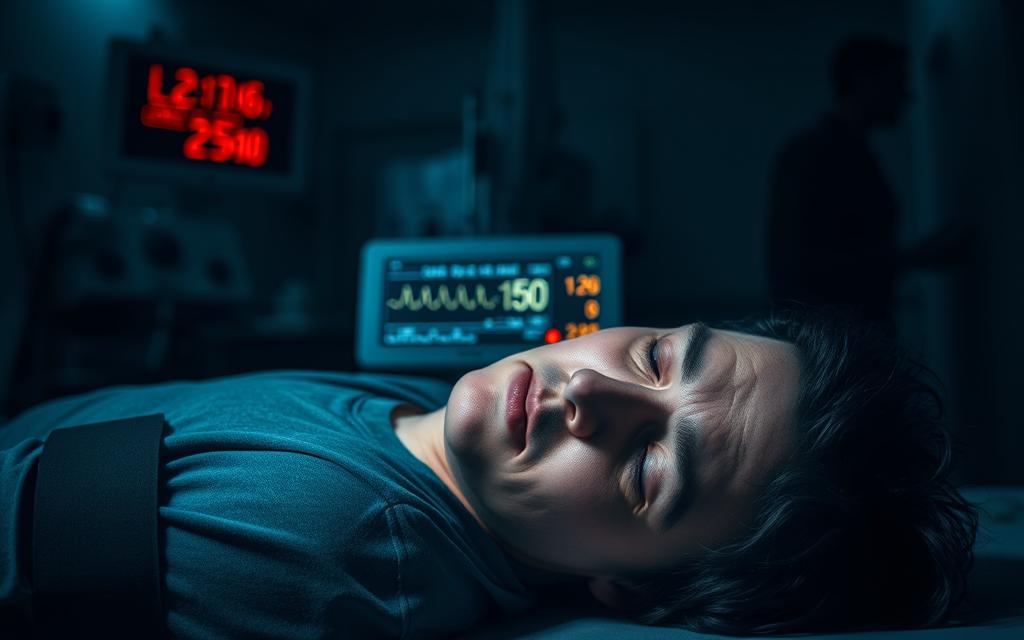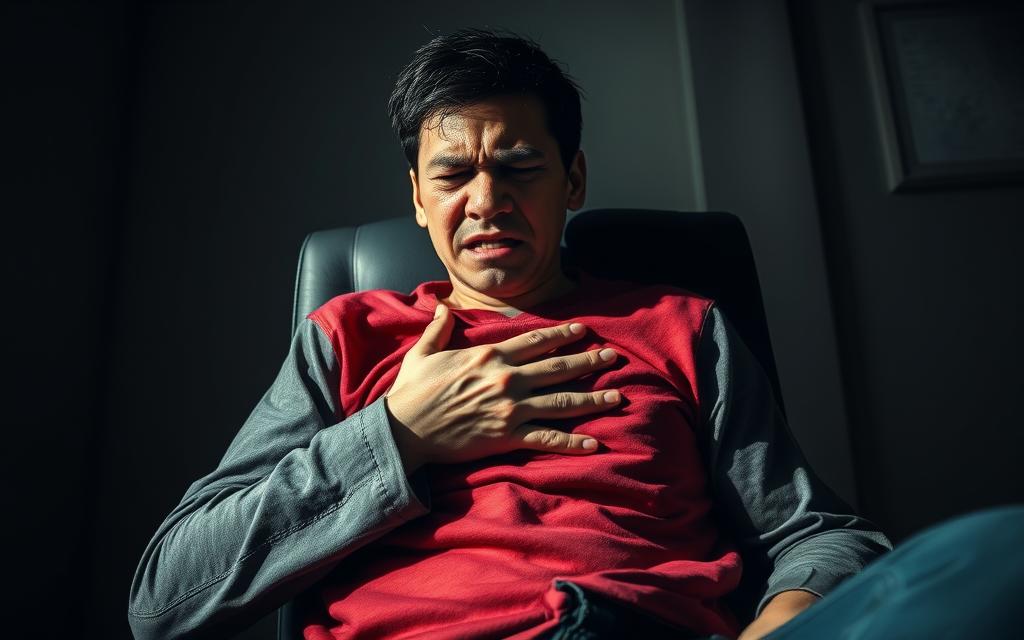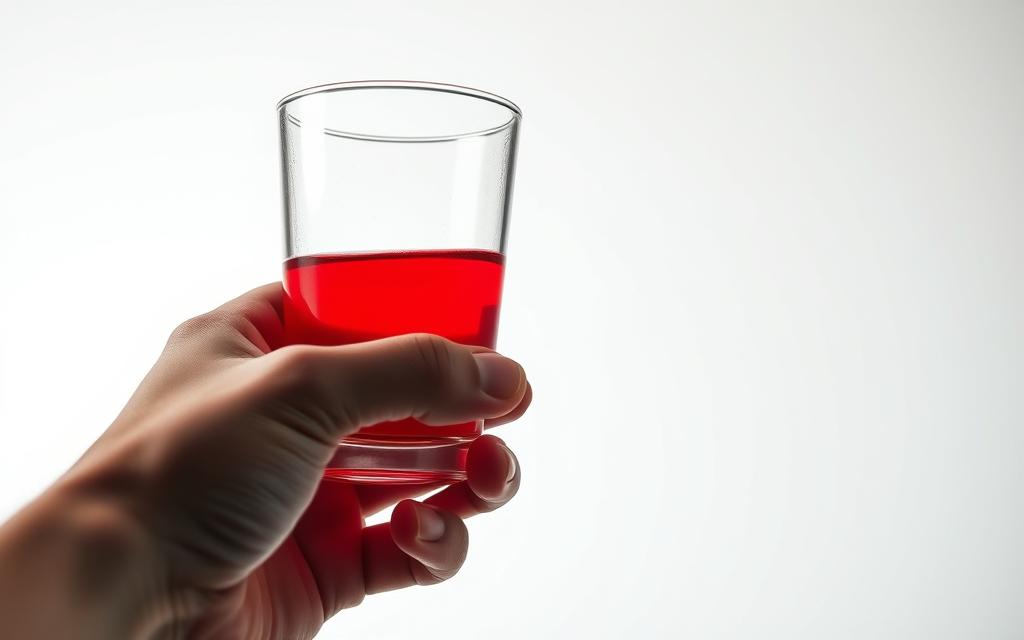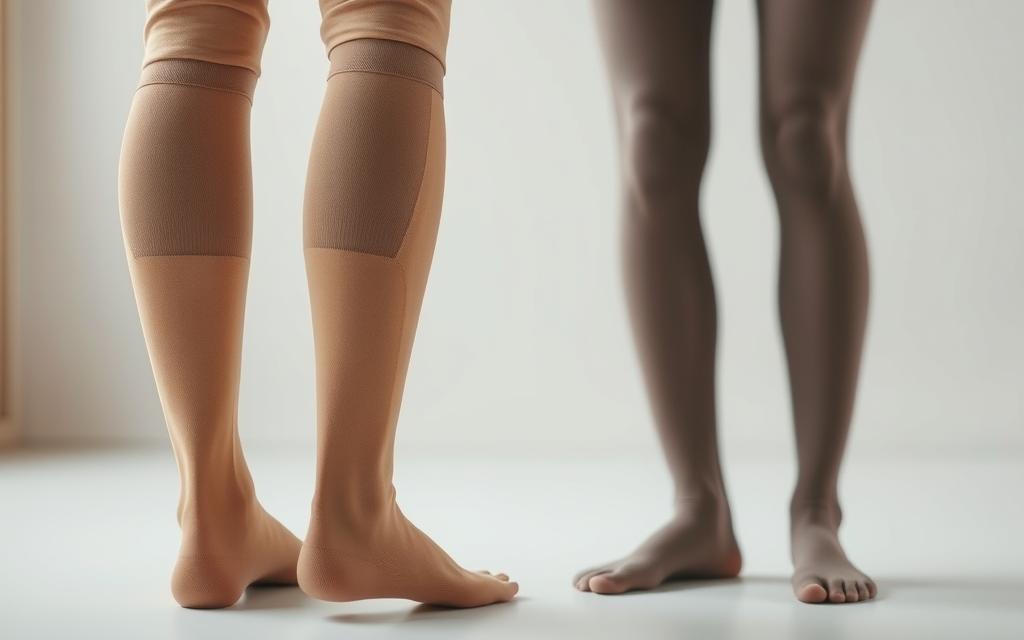We’ve all felt lightheaded or weak without warning. Low blood pressure can sneak up on us, making us feel vulnerable. It’s important to know how to handle this to keep ourselves safe and healthy.
When we’re in a crisis, knowing how to quickly raise our blood pressure is key. This knowledge can turn a scary moment into a quick recovery. Let’s look at some important steps to tackle low blood pressure and take charge of our health.
Key Takeaways
- Understanding low blood pressure is crucial for recognizing symptoms.
- Emergency measures can provide quick relief from hypotension.
- Proper hydration plays a significant role in managing blood pressure.
- Caffeinated beverages can act as a short-term solution.
- Awareness of personal health patterns is essential for prevention.
- Regular check-ups help maintain overall health and monitor blood pressure.
Understanding Low Blood Pressure
Low blood pressure, or hypotension, can really impact our health. It’s key to know what causes and symptoms it has. This knowledge helps us deal with hypotension better.
Definition of Hypotension
Hypotension means blood pressure is under 90/60 mmHg. It shows our heart might not send enough blood to our body. Some people naturally have low blood pressure, but it’s a problem if it causes symptoms.
Common Causes of Low Blood Pressure
There are many reasons for low blood pressure. Here are some common ones:
- Dehydration: Not drinking enough water lowers blood volume.
- Medications: Some drugs, like diuretics and antidepressants, can drop blood pressure.
- Heart problems: Issues like bradycardia or heart valve problems can affect blood flow.
- Endocrine issues: Problems with the adrenal glands, like Addison’s disease, can cause low blood pressure.
- Severe infections: Septicemia can cause a big drop in blood pressure.
Symptoms Indicating Low Blood Pressure
It’s important to know the symptoms of low blood pressure. This way, we can get help quickly. Common signs include:
- Dizziness or lightheadedness
- Fainting
- Cold, clammy skin
- Nausea
- Fatigue
Why Low Blood Pressure Can Be Dangerous
Low blood pressure is often ignored but it’s very serious. It harms our vital organs, which need constant blood flow to work right. Knowing the risks of low blood pressure is key to staying healthy.
Impact on Vital Organs
Low blood pressure can hurt organs like the heart, brain, and kidneys. They don’t get enough blood, oxygen, or nutrients. This can cause serious problems, like organ damage and failure, over time.
Potential Risks of Sudden Drops in Blood Pressure
A sudden drop in blood pressure is even more dangerous. It can cause dizziness, fainting, or shock. In bad cases, it might even lead to losing consciousness, which can cause injuries from falls or accidents. We need to watch for these signs to avoid the dangers of hypotension.

| Symptom | Potential Consequence |
|---|---|
| Dizziness | Increased risk of falls |
| Fainting | Possible head injury from falls |
| Shock | Organ failure |
Recognizing a Blood Pressure Emergency
It’s important to spot the signs of a blood pressure emergency early. We need to know that some symptoms mean we need help right away. Acting fast can help avoid serious problems.
Signs of a Critical Situation
When we face a blood pressure emergency, we must watch for warning signs. Fainting or feeling dizzy, having very cold or sweaty skin, and feeling extremely weak are big red flags. Seeing these signs can tell us a lot about our health.
When to Seek Immediate Medical Attention
If we see these serious symptoms, we should get medical help fast. Quick action is key because these signs might mean we have a serious health issue. Ignoring them can be very dangerous, so getting checked out right away is vital.

Emergency Measures to Raise Blood Pressure
When blood pressure drops, we must act fast to stay safe. Quick strategies can help raise blood pressure. By adjusting our body position, staying hydrated, and using counterpressure, we can tackle low blood pressure.
Adjusting Body Position Safely
Getting our body in the right position is key. If blood pressure is low, lie down and lift your legs. This helps blood flow back to the heart and boosts circulation.
Keeping your upper body flat is also important. It helps keep enough blood in important areas.
The Importance of Hydration
Drinking enough water is vital for blood pressure. Drinking water or electrolyte-rich drinks can increase blood volume. This keeps our body working well, which is crucial when blood pressure is low.
Counterpressure Techniques to Consider
Using counterpressure methods can help raise blood pressure quickly. Tensing leg muscles, for example, can improve blood flow. These methods, along with others, can quickly stabilize blood pressure.

Using Compression Garments Effectively
Managing low blood pressure can be a challenge. One effective solution is using compression garments. These items apply pressure to certain body areas. This helps improve blood circulation.
Types of Compression Garments
There are different types of compression garments for various needs:
- Compression stockings: These are often worn on the legs to prevent blood from pooling.
- Abdominal binders: These support the abdominal region and help stabilize blood flow.
- Arm sleeves: Designed to enhance circulation in the upper extremities.
How They Aid in Blood Circulation
Compression garments improve blood circulation. They apply pressure to help blood flow back to the heart. This reduces the risk of low blood pressure.
Wearing these garments can help keep blood pressure stable. It’s a valuable part of managing low blood pressure.

| Type of Compression Garment | Benefits |
|---|---|
| Compression Stockings | Helps to prevent blood pooling and reduce swelling in the legs. |
| Abdominal Binders | Encourages blood flow back to the heart and stabilizes blood pressure. |
| Arm Sleeves | Improves circulation in the arms and reduces fatigue. |
Dietary Adjustments for Increased Blood Pressure
Making changes to our diet can greatly affect our blood pressure. One key change is to increase our salt intake for blood pressure. It’s also important to stay hydrated to keep fluid balance in the body. These steps help keep our health in check and stabilize our blood pressure.
Importance of Salt Intake
Increasing salt intake can help raise our blood pressure levels. Sodium is crucial for fluid balance and blood volume. It’s important to watch our salt intake to avoid too much, as it can cause other health problems.
Hydration Strategies with Water
Drinking enough water is key for managing blood pressure. It helps improve blood volume, which is good for blood pressure. We can make drinking water a habit by carrying a water bottle and setting reminders to drink it throughout the day.

Caffeinated Beverages: A Quick Fix
Caffeinated drinks can quickly help with low blood pressure. Coffee is a top choice because it’s so popular and effective. Knowing how coffee affects blood pressure helps us choose our caffeine wisely.
How Coffee Affects Blood Pressure
Caffeine in coffee boosts the nervous system, raising blood pressure briefly. This effect changes based on how our body handles it. People who drink coffee often might not feel as much of an effect. It’s smart to watch how our body reacts to stay safe.
Other Sources of Caffeine
Other than coffee, many drinks have caffeine too. Tea, energy drinks, and some soft drinks are examples. Each has different caffeine levels, so knowing what we drink is key. For instance, a coffee cup often has more caffeine than a black tea cup. Understanding these differences helps us manage our blood pressure better.

Physical Maneuvers to Elevate Blood Pressure
Doing specific physical activities can help increase our blood pressure. Certain exercises boost our heart rate and improve blood flow. It’s key to stay active, mainly when we feel dizzy or have low blood pressure.
Exercises to Encourage Blood Flow
Targeted exercises can really help improve circulation and raise blood pressure. Here are some good ones:
- Leg-Crossing Exercises: Crossing and uncrossing our legs while sitting can help enhance blood circulation.
- Wall Sits: Sitting against a wall and engaging our leg muscles promotes blood flow.
- Calf Raises: Standing and raising our heels can improve circulation to the heart.
- Light Jogging in Place: This exercise raises our heart rate and boosts circulation instantly.
Breathing Techniques for Stress Relief
When we’re anxious or feeling stressed, it’s important to use stress relief techniques. Controlled breathing helps lower stress and keeps blood pressure healthy. Here are some methods:
- Deep Breathing: Breathe in deeply through the nose, hold, and then breathe out slowly through the mouth. It calms our nervous system.
- 4-7-8 Breathing: Breathe in for four seconds, hold for seven, and breathe out for eight. It helps us relax.
- Diaphragmatic Breathing: Using our diaphragm for deeper breaths can also reduce stress.
Combining physical activity and stress relief techniques helps us manage blood pressure changes well.

The Role of Stress Management
Stress management is key to keeping our health in check, focusing on blood pressure. Chronic stress can cause blood pressure to swing, making it vital to find ways to lessen its impact.
How Stress Affects Blood Pressure
Stress sets off our body’s fight-or-flight response, releasing hormones that raise blood pressure. This reaction speeds up our heart rate and narrows blood vessels. If stress isn’t managed, it can keep blood pressure high. By controlling stress, we can help keep our blood pressure stable and protect our heart.
Deep Breathing Techniques
Adding deep breathing exercises to our day can really help with stress. Methods like box breathing or the 4-7-8 technique calm our minds and lower anxiety. Doing these exercises often can help manage stress and might even help keep blood pressure in check.

Recognizing Symptoms of Low Blood Pressure
When we talk about low blood pressure symptoms, we often think of the obvious signs. Knowing these signs is key to our health. Spotting early symptoms like dizziness and cold skin can help us act fast.
Dizziness and Lightheadedness
Dizziness is a common sign of low blood pressure. It can feel like a mild wobble or a strong feeling that makes us lose balance. It usually happens when we stand up too fast or after sitting or lying down for a long time. These feelings can be scary and make us check our blood pressure.
Cold, Clammy Skin and Sweating
Cold, clammy skin is another sign of low blood pressure. It might also make us sweat a lot, even when it’s not hot. Our body tries to cool down when blood pressure is low, making us feel cold. Spotting this symptom early is important to keep our health safe.

Understanding Long-Term Management
Managing low blood pressure well needs careful planning. Regular check-ups help us keep in touch with our doctors. This way, we can watch our condition and change our plans if needed.
Blood pressure checks become a key part of our daily routine. They help us know how our health is doing.
Regular Check-Ups and Monitoring
Seeing our doctor regularly helps us notice any blood pressure changes. These visits are great for talking about our health ups and downs. We can also check if our long-term plans are working well together.
By keeping track of our blood pressure, we can spot any big changes. This helps us know when we need to take action.
How to Measure Blood Pressure at Home
Learning to check your blood pressure at home is powerful. Using an automatic cuff makes it simple to get accurate readings. It’s good to check your blood pressure at different times to get a full picture.
Writing down these readings helps us see patterns. We can share this info with our doctor during visits.
When to Contact Healthcare Providers
It’s important to notice when low blood pressure happens often. If it keeps happening or gets worse, it might mean there’s a bigger issue. We should watch for these signs and talk to our doctors to make sure we’re okay.
Patterns of Recurring Low Blood Pressure
Keep an eye on your blood pressure and look for any odd patterns. If you feel dizzy, tired, or faint a lot, it’s time to see a doctor. Spotting these patterns can help find the cause and guide what to do next.
Collaborating with Your Doctor for Treatment Options
Talking openly with our doctors about treatment is key. We can work together to find the best way to handle low blood pressure. This teamwork helps us try different treatments, change medications, or make lifestyle changes for better health.
Alternative Treatments and Their Effectiveness
Managing hypotension involves looking at both standard and alternative treatments. While some may need medication, others find relief in natural remedies. Knowing these options helps us choose what’s best for our health.
Medications for Low Blood Pressure
Doctors often prescribe certain drugs to increase blood pressure. Here are some common ones:
- Fludrocortisone – a corticosteroid that helps the body retain salt, leading to increased blood volume.
- Midodrine – an alpha-adrenergic agonist that raises blood pressure by constricting blood vessels.
- Droxidopa – a synthetic amino acid used to manage neurogenic orthostatic hypotension, often providing rapid relief.
Natural Remedies Worth Considering
There are also natural ways to help raise blood pressure:
- Salt intake – increasing sodium consumption can help raise blood pressure levels.
- Herbal supplements – options such as licorice root have traditionally been used to boost blood pressure.
- Caffeine – drinking coffee or tea can lead to short-term increases in blood pressure.
These natural remedies can work alongside medication. They help us manage low blood pressure in a more holistic way. By exploring both, we can find what works best for us.
Preventive Measures for Future Episodes
To avoid low blood pressure episodes, we need to take preventive steps. A healthy lifestyle and smart choices are key. Simple changes like eating right, exercising, and staying hydrated can help a lot.
Healthy Eating and Lifestyle Choices
Eating a balanced diet is crucial for our health. Foods high in fiber and potassium are good for our heart. It’s also important to cut down on sugar and salt.
Getting enough sleep and managing stress are also vital. These habits help keep our blood pressure in check.
Exercising Safely to Promote Blood Health
Exercising regularly helps keep our blood pressure balanced. Activities like walking, swimming, or cycling are great. They raise our heart rate without being too hard on our bodies.
Start slowly and increase the intensity over time. This approach is better for our blood pressure and overall health. Remember to drink water before, during, and after exercising to avoid blood pressure drops.
Conclusion
Managing blood pressure is crucial, and knowing how to raise it quickly in emergencies is key. Understanding hypotension helps us act fast when blood pressure drops. We’ve looked at ways like changing our diet, staying hydrated, and using physical methods to help.
This guide shows how important it is to spot symptoms early and work closely with doctors. This teamwork helps us keep our blood pressure in check and avoid the dangers of low blood pressure. By being proactive, we can respond quickly when needed.
Learning and using these strategies makes us healthier and safer. By staying alert and using the methods we’ve talked about, we can handle low blood pressure better. This helps us stay well overall.
FAQ
What is considered low blood pressure?
Low blood pressure, or hypotension, is when blood pressure is below 90/60 mmHg. If we see this or lower, it’s a sign to act fast.
What are the common symptoms of low blood pressure?
Signs include dizziness, fainting, and cold skin. We also might feel lightheaded or extremely weak. Spotting these symptoms early is key.
Why is low blood pressure dangerous?
It can harm vital organs by cutting off blood flow. This might lead to shock or organ failure. If symptoms show up, we need to act quickly.
How can we quickly raise blood pressure in an emergency?
To quickly raise blood pressure, try changing body positions or staying hydrated. Counterpressure techniques and compression garments can also help improve circulation.
What dietary changes can help manage low blood pressure?
Eating more salt can help raise blood pressure. Drinking plenty of water is also crucial to increase blood volume.
How do caffeinated beverages affect blood pressure?
Drinks like coffee can quickly raise blood pressure. But, it’s important to drink them in moderation and stay hydrated.
Can physical exercises help with low blood pressure?
Yes, doing leg crosses or light exercises can boost blood flow. This can help raise blood pressure levels.
What role does stress management play in blood pressure control?
Stress can change blood pressure. Deep breathing can help reduce stress and keep blood pressure stable.
How can we monitor our blood pressure effectively?
Regular doctor visits and learning to measure blood pressure at home are key. This helps us track levels and talk to doctors effectively.
When should we consult a healthcare provider about low blood pressure?
If low blood pressure happens often or symptoms get worse, see a doctor. They can find the cause and suggest treatments.
Are there alternative treatments for managing low blood pressure?
Yes, there are medicines to stabilize blood pressure. Some people also find natural remedies helpful as part of their treatment plan.
What preventive measures can we take to avoid low blood pressure episodes?
Eating well, staying hydrated, exercising regularly, and managing stress are important. These habits help keep blood pressure stable and prevent episodes.
